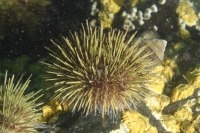
(Photo: Claire Goodwin)
Green Sea Urchin
Strongylocentrotus droebachiensis
This green, spiky urchin can grow to 10 centimetres in diameter but is usually around five to six centimetres. It grows at a rate of approximately 10 millimetres per year until it reaches its maximum size. Atlantic Ocean urchins may live for up to 25 years.
Authority
O.F. Müller, 1776
Classification Details
Phylum: Echinodermata (echinoderms); Class: Echinoidea (sea urchins, sand dollars, and heart urchins).
Habitat
Found in northern waters in both the Pacific and Atlantic Oceans from the Arctic down to New Jersey (Atlantic) and Puget Sound (Pacific). Occurs from the intertidal to depths of over 1 000 metres. Common on rocky shores and in kelp beds.
Diet
Feed mainly on seaweeds such as kelp. Also sometimes eat animals and coralline algae. Urchins use a rigid dental structure known as Aristotle’s lantern to scrape food from the rock. It has five triangular teeth and strong muscles.
Reproduction
Sea urchins can be male or female. They release eggs and sperm directly into the water. Mass spawning usually occurs in spring and is triggered by water temperature. The swimming larvae eventually settle on the sea floor and develop into adults.
Fun Facts
If sea urchins become too abundant, they can create areas with no kelp. These are known as urchin barrens. But if there aren’t enough urchins, kelp may become over-abundant. It is important to manage outside pressures as far as possible to keep the ecosystem balanced. Infection by the amoeba Paramoeba invadens sometimes causes mass mortality of sea urchins. Sea urchins are also fished commercially in the Bay of Fundy – their gonads are edible and regarded as a delicacy by some people.
References
Brady SM and Scheibling RE (2005) Repopulation of the shallow subtidal zone by green sea urchins (Strongylocentrotus droebachiensis) following mass mortality in Nova Scotia, Canada. Journal of the Marine Biological Association of the United Kingdom 85, 1511–1517. Scheibling RE and Hatcher BG (2001) The ecology of Strongylocentrotus droebachiensis. In: Edible sea urchins: biology and ecology (J.M. Lawrence, ed). Developments in Aquaculture and Fisheries Science No. 32, Elsevier Science Press, Amsterdam, London, New York, Oxford, Paris, Shannon, Tokyo. Van Guelpen L, Pohle G, Vanden Berghe E and Costello MJ (2005) Marine Species Registers for the North Atlantic Ocean. World Wide Web electronic publication. http://www.vliz.be/vmdcdata/narms/

